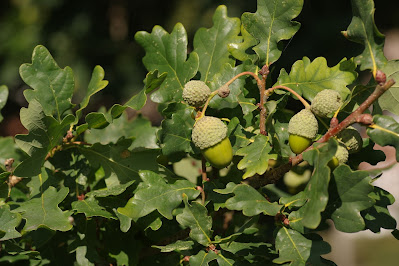On the 13th of September, two and a half months after the 5th survey, I completed the 6th and final survey of our garden wild flowers. Previously, I had been doing surveys once every few weeks but the rush of growth has slowed right down and I had to wait for the new plants to grow big enough for identification.
This time, there were just four new species to add to the list.
The first of these was Fat-hen (Chenopodium album). According to to Mabey's Flora Britannica, this member of the spinach family, was a popular crop during pre-historic times.
Another was Junglerice (Echinochloa colona), which was growing near the bird table - maybe this came from the bird seed. The other two newcomers to the list were Red Clover (Trifolium pratense) and Goat Willow (Salix caprea).
Many of the plants, I recorded as flowers in spring are now fruiting.
The hawthorn (Crataegus monogyna) has fine red berries.
Blackthorn (Prunus spinosa) berries have a gentle blue bloom.
The Acorns (Quercus robur) have reached their full size.
Meanwhile, some summer flowers such as Catsear (Hypochaeris radicata) have kept on flowering for weeks.
There has been some very unseasonable behaviour from some spring flowers. The Marsh Marigold (Caltha Palustris) is having a second flush of flowers. In the Uckfield area, I have seen both hawthorn and apple in blossom.
For the BSBI Garden Wild Flower Hunt, I have recorded a total of 107 species of wildflowers and plants, of which:
- 79 probably occurred naturally in our garden
- 28 were sown or planted.
I was amazed to get so many - especially finding species that I had not noticed before. The other surveys were:
- 10th April 2020
- 25th April 2020
- 16th May 2020
- 6th June 2020
- 27th June 2020
- 13th September 2020







No comments:
Post a Comment